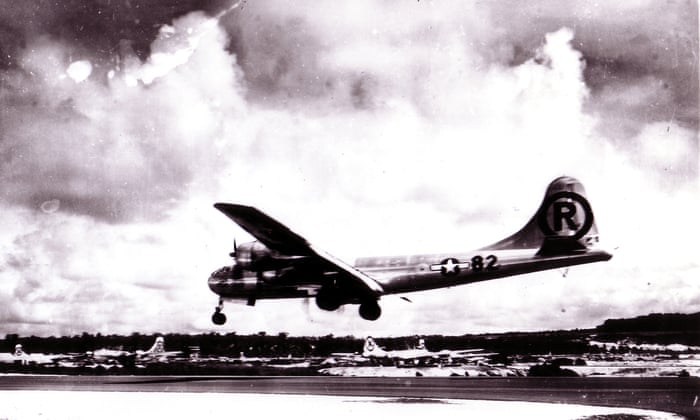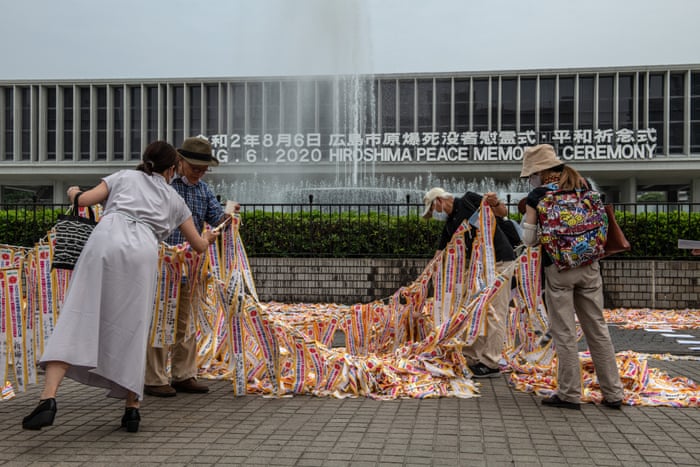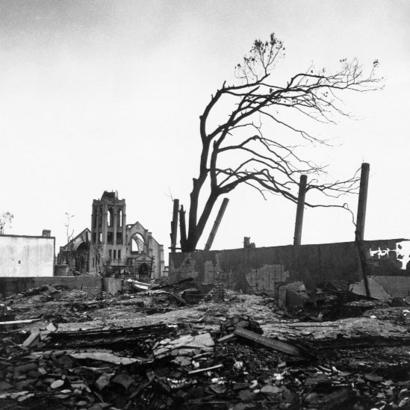 |
| The Enola Gay lands at the Tinian airbase in the Mariana Islands after the bombing of Hiroshima. Did the B-29 Superfortress bomber herald a new age of nuclear terror? P |
Hiroshima at 75: bitter row persists over US decision to drop the bomb
Historians and military differ on whether 1945 bombing ended the war and saved countless lives – or was an unconscionable act of brutality
Julian Borger in Washington
Wed 5 Aug 2020 06.45 BST
Seventy-five years after it dropped the atomic bomb on Hiroshima, the Enola Gay stands, restored and gleaming, as a museum exhibit close to Washington’s Dulles airport.
It was not always so well looked after. For decades after the war, the B-29 Superfortress bomber was left to rot. It was disassembled, its pieces were scattered, birds nested in its engines, and someone smashed its gun turret.Behind the neglect lay a deep national ambivalence about what it represented, a quandary which endures today: was this the aircraft that finally ended the second world war, saving hundreds of thousands of lives – or the instrument of the mass killing of civilians, which heralded a new age of nuclear terror?
When the Enola Gay was part restored and plans were made to put in on display at the National Air and Space Museum in 1995, historians agonised over how the exhibit might look at its legacy from all sides. It did not go well.
In the face of an outcry from air force veterans, who said the exhibition would put Japanese and US responsibility on the same moral plane, the curators scaled back or eliminated the elements focused on the 140,000 people killed in Hiroshima, and the ensuing nuclear arms race. For the critics, even that was not enough. The museum’s director, Martin Harwit, was forced to resign.When the plane was fully restored and moved to the museum’s spectacular new building near Dulles in 2003, there were protests from Japanese survivors and others. Red paint was hurled, denting the airframe.
In the wake of those battles, the inscription below the Enola Gay today is minimal and bland.
“Although designed to fight in the European theater, the B-29 found its niche on the other side of the globe. In the Pacific, B-29s delivered a variety of aerial weapons: conventional bombs, incendiary bombs, mines, and two nuclear weapons,” it reads.
All reference to the moral, political and historical debate over the bombing of Hiroshima on 6 August 1945 – and then Nagasaki three days later – has been left off the public display, but that has not stopped the row from surfacing in the days leading up to the 75th anniversary on Thursday.
The disagreements are not limited to historians. While the air force view – which reflects US orthodoxy – is that the use of atomic weapons stopped the war and prevented much worse bloodshed, the National Museum of the US Navy has a different take.
“The vast destruction wreaked by the bombings of Hiroshima and Nagasaki and the loss of 135,000 people made little impact on the Japanese military,” it says on a plaque beside a replica of Little Boy, the bomb Enola Gay dropped on Hiroshima.
“However, the Soviet invasion of Manchuria on 9 August – fulfilling a promise of the Yalta conference in February – changed their minds.”
The plaque reflects the views of US navy leadership at the time.
 |
| Peace activists arrange ribbons near the Hiroshima memorial museum. About 140,000 people were killed in the bombing. Photograph: Carl Court/Getty Images |
“[T]he use of this barbarous weapon at Hiroshima and Nagasaki was of no material assistance in our war against Japan. The Japanese were already defeated and ready to surrender,” wrote Adm William Leahy, who presided over the combined US-UK chiefs of staff.
The general who had won the war in Europe months earlier, Dwight Eisenhower, recalled his reaction to being told by the secretary of war, Henry Stimson, that the atomic bomb would be used.
“I voiced to him my grave misgivings, first on the basis of my belief that Japan was already defeated and that dropping the bomb was completely unnecessary, and secondly because I thought that our country should avoid shocking world opinion by the use of a weapon,” Eisenhower told his biographer, Stephen Ambrose.
One of the most contentious issues remains the role of the US secretary of state, James Byrnes, in influencing the decisions of the new president, Harry Truman, who was inexperienced in foreign policy.
At the Potsdam conference in mid-July 1945, which brought together Truman, Joseph Stalin and Winston Churchill (replaced during the summit by Clement Attlee), an ultimatum was issued to Japan to surrender. Byrnes was instrumental in removing a paragraph offering to allow Emperor Hirohito to retain his title, the primary Japanese condition.“The proclamation was issued without any assurances, knowing that it could not be accepted, and then the bombs went forward,” said the historian Gar Alperovitz, a professor of political economy at the University of Maryland and the author of two books on the diplomacy surrounding the decision to use atomic weapons.
Michael Kort, a social sciences professor at Boston University, who wrote The Columbia Guide to Hiroshima and the Bomb, argues the inclusion of the offer in the Potsdam declaration would not have shortened the war on its own.
“The Japanese military had a whole bunch of other other conditions as well,” Kort said. “Also, what we meant was the Emperor stays on the throne as a constitutional monarch. What the Japanese meant was their demand that the Emperor remain with all his powers.”
When the Enola Gay dropped the first atomic bomb on Hiroshima on 6 August, the Japanese ambassador in Moscow was sounding out the Soviets on terms for a negotiated end to the war.
The destruction of Hiroshima did not change the Japanese negotiating position. That came with a double blow starting two days later. On the evening of 8 August, the Soviets announced they would be entering the war against Japan, as Stalin had promised Franklin Roosevelt and Churchill at Yalta. Hours after that, the second atomic bomb was dropped on Nagasaki.
Historians are divided over whether the bombs or the Soviet declaration alone might have ended the war.
“Despite the Hiroshima bomb, the Japanese government still continued to seek the termination of the war through Moscow’s mediation,” said Tsuyoshi Hasegawa, former research professor at the University of California in Santa Barbara, and an expert on Soviet-Japanese diplomacy at the time.
“I would say that the Soviet entry into the war had a more decisive impact on the decision to surrender than the atomic bombs.”
That view is disputed by the Rev Wilson Miscamble, a history professor at the University of Notre Dame.
“Even after the Soviet entry into the war, certain elements of the Japanese military wanted to continue fighting. But it was Hirohito’s motivation, brought on by his recognition of the damage of the bombs, that brought him to engage directly with his government, and to order the surrender,” Miscamble said.
 |
| Hiroshima |
“So, if the bomb was most decisive on Hirohito, and if Hirohito was the most decisive figure in ordering surrender, I think we can conclude that the bombs were the decisive element in bringing about Japan’s surrender.”
The US invasion of the Japanese home islands was not due until November, so some have argued Truman could have put off the decision to use atomic weapons for some time to see what effect the Russian intervention would have. Alperovitz argues that the timing of the bombs was aimed at stopping the war before the Red Army moved too deep into Manchuria.
“It is not an accident the bombs were dropped on 6 August and 9 August, just around the time we had expected the Russians to enter the war,” he said.
Miscamble argues that takes too narrow a view of the scope of the war and the number of lives at stake.
“The object was to end the war as quickly as possible, because lives were being lost all over Asia,” he said. “Would it really have been moral to stand aside so as to maintain one’s supposed moral purity, while a vast slaughter occurred at the rate of over 200,000 deaths a month? Is there not a tragic dilemma here – which innocent lives to save?”


No comments:
Post a Comment